|
|
|
Sort Order |
|
|
|
Items / Page
|
|
|
|
|
|
|
| Srl | Item |
| 1 |
ID:
157493
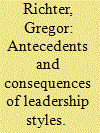

|
|
|
|
|
| Summary/Abstract |
There are numerous studies on the success of various leadership styles that refer to the link between styles and levels of performance and other relevant organizational parameters. Data from a recent survey in a multinational headquarters (HQs) replicate previous findings on leadership style concerning the preferences of the subordinates for more participation in decision-making. Although multinational HQs are in many ways unique organizations that could present unique leadership challenges, too, the findings using traditional models of leadership show how similarly, compared to civilian companies and public administrations, leadership styles are perceived and evaluated by subordinates. Apart from that, the survey data indicate that leadership style—quite different from what was expected—has no significant effect on “organizational commitment” and “mission clarity.” The reasons for that result are discussed against the backdrop of the peculiarities of the organization under investigation.
|
|
|
|
|
|
|
|
|
|
|
|
|
|
|
|
| 2 |
ID:
157490
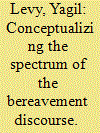

|
|
|
|
|
| Summary/Abstract |
This article presents the spectrum of the bereavement discourse, namely, how various social groups interpret the loss of their children’s lives or the potential risk to their lives posed by their military service and translate it into public discourse, as a spectrum of attitudes. It is argued that this spectrum ranges from subversive to submissive approaches. Furthermore, within the confines of the declining casualty tolerance, two variables cumulatively determine the actors’ choice of discourse: the level of enforcement of recruitment, ranging from conscription to voluntary recruitment, and the social position of the group to which the agents belong. Given that conscription brings powerful, high-status groups into the ranks who may be unwilling to make sacrifices for war, subversive responses are more likely to occur in conscript militaries than in volunteer forces and vice versa. This article maps this spectrum and hypothesizes about its determinants.
|
|
|
|
|
|
|
|
|
|
|
|
|
|
|
|
| 3 |
ID:
157492


|
|
|
|
|
| Summary/Abstract |
Do military endorsements influence Americans’ political and foreign policy views? We find that senior military officers have the ability to nudge public attitudes under certain conditions. Through a series of large, survey-based experiments, with nearly 12,000 completed interviews from national samples, we find that participants respond to survey questions in predictable ways depending on whether they have been prompted with information about the views of senior military leaders on the very same questions. When told that senior military leaders oppose particular interventions abroad, public opposition to that intervention increases; endorsements of support boost public support but by a smaller magnitude. Subsequent causal mediation analysis suggests that military opinion influences public opinion primarily through its impact on a mission’s perceived legitimacy and, to a lesser degree, it’s perceived likelihood of success.
|
|
|
|
|
|
|
|
|
|
|
|
|
|
|
|
| 4 |
ID:
157495
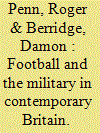

|
|
|
|
|
| Summary/Abstract |
This article examines the relationship between football (soccer) and the military in Britain to explore how “invisible nationalism” has evolved. Here, invisible nationalism refers to the phenomena by which the presence of the military at major British sporting events is both highly visual and has been rendered culturally and politically invisible: It is hidden “in plain sight.” We applied the conceptual framework associated with the “Annales” School of structuralist history to explore how the inextricable links between football, the military, the monarchy, and established church have influenced the evolution of invisible nationalism. We conducted ethnographic fieldwork, including observations, interviews, and focus groups, and also analyzed visual data. These comprised television broadcasts of national sporting events and figures taken at English football clubs. We conclude that the power of the dominant metanarratives of British nationalism serves to render these phenomena invisible to most spectators, especially those who consume football via television.
|
|
|
|
|
|
|
|
|
|
|
|
|
|
|
|
| 5 |
ID:
157496


|
|
|
|
|
| Summary/Abstract |
The United States and Canada, among others, have recognized that “misconduct stress behaviors” can be a “hidden” by-product of war-zone deployments. The American military’s paradigm of punishment over treatment creates a “military misconduct Catch-22,” in which the service member’s treatment need is identified as a result of, or only after, violations of military law. Civilian society then bears the justice, familial, and social costs of the military’s failure to address combat stress–based misconduct. As an alternative to existing punitive military pathways, we propose a rehabilitative justice pathway that builds on the successes of civilian criminal justice mental health courts—to be implemented during active duty service, before separation from the Armed Forces. The approach, predicated on the circumstances of each case, promotes resilience, honorable discharge, and successful reintegration of service members into society.
|
|
|
|
|
|
|
|
|
|
|
|
|
|
|
|
| 6 |
ID:
157491
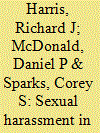

|
|
|
|
|
| Summary/Abstract |
Sexual harassment remains a persistent problem in the U.S. military despite extensive research and policy initiatives. Theoretical explanations identify individual circumstances (e.g., power differentials) and organizational factors (e.g., climate, culture). However, data constraints limit the capacity to link individual contexts with independent measures of environments.
|
|
|
|
|
|
|
|
|
|
|
|
|
|
|
|
| 7 |
ID:
157497
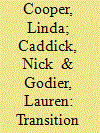

|
|
|
|
|
| Summary/Abstract |
In this article, we employ the theoretical framework and concepts of Pierre Bourdieu to examine the notion of “transition” from military to civilian life for U.K. Armed Forces personnel. We put Bourdieu’s concepts of habitus, capital, and field to work in highlighting key differences between military and civilian life. The use of social theory allows us to describe the cultural legacy of military life and how this may influence the posttransition course of veterans’ lives. There may be positive and negative transition outcomes for service personnel when moving into civilian life, and by applying Bourdieu’s theoretical concepts, we explain how such outcomes can be understood. We suggest that the “rules” are different in military environments compared to civilian ones and that service personnel must navigate a complex cultural transition when moving between environments. There are numerous and significant implications—including policy applications—from understanding transition through a Bourdieusian lens, and these are highlighted throughout.
|
|
|
|
|
|
|
|
|
|
|
|
|
|
|
|
| 8 |
ID:
157494


|
|
|
|
|
| Summary/Abstract |
Support for U.S. military personnel appears high, but does it extend to veterans after service ends? This study evaluates public support for social engagement with veterans and spending on recent military veterans’ health care and estimates the extent of socially desirable reporting on these forms of support. It uses a list experiment to identify the extent of socially desirable reporting on topics. Findings demonstrate that the public offers overwhelming support for spending on veterans’ health care and social engagement with the group, but they somewhat overstate this support. Support differs by age, race, and political ideology, and social desirability bias varies by race, political ideology, and prior military experience. African Americans express the lowest levels of support for returning veterans and the greatest extent of socially desirable reporting on that support. This is despite generally high rates of service and greater labor market returns to that service among this demographic group.
|
|
|
|
|
|
|
|
|
|
|
|
|
|
|
|
|
|
|
|
|